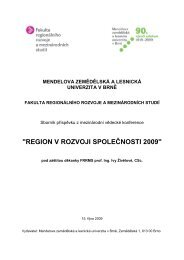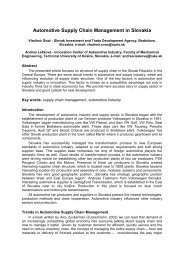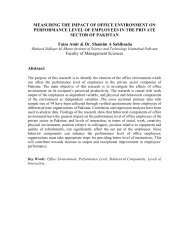performance evaluation in the hospitality industry - Icabr.com
performance evaluation in the hospitality industry - Icabr.com
performance evaluation in the hospitality industry - Icabr.com
You also want an ePaper? Increase the reach of your titles
YUMPU automatically turns print PDFs into web optimized ePapers that Google loves.
Also, <strong>the</strong> need arises to question whe<strong>the</strong>r <strong>the</strong> Dimensions and Objectives/KRAs identified by<br />
management (supply side) <strong>in</strong> reality reflect what <strong>the</strong> hotel guests (demand side) consider to<br />
be critical to <strong>the</strong>ir actual and post-consumption satisfaction.<br />
Ba<strong>in</strong> & Company‟s report “Management Tools and Trends”, surveys executives at<br />
<strong>com</strong>panies of vary<strong>in</strong>g size around <strong>the</strong> world. In <strong>the</strong> report released on 1 st May, 2009 (Ba<strong>in</strong> &<br />
Company‟, 2009), <strong>the</strong> BSC ranked high <strong>in</strong> both usage and satisfaction, actually improv<strong>in</strong>g <strong>in</strong><br />
both categories s<strong>in</strong>ce <strong>the</strong> previous report.<br />
Of <strong>the</strong> twenty-five management tools considered <strong>in</strong> <strong>the</strong> survey, <strong>the</strong> BSC ranked 6 th <strong>in</strong> usage<br />
and 8 th <strong>in</strong> terms of satisfaction. The top four tools (Benchmark<strong>in</strong>g, Strategic Plann<strong>in</strong>g,<br />
Mission and Vision Statements, and CRM) also happen to be prime movers <strong>in</strong> Strategic<br />
Plann<strong>in</strong>g. Moreover, <strong>the</strong> BSC is used heavily throughout <strong>the</strong> world with, accord<strong>in</strong>g to Ba<strong>in</strong> &<br />
Company, a full 49% - 56% of all <strong>com</strong>panies surveyed us<strong>in</strong>g <strong>the</strong> BSC with a global spread.<br />
The report also highlights that <strong>the</strong> heaviest use of <strong>the</strong> BSC is among large corporations with<br />
turnover <strong>in</strong> excess of USD 2 billion per annum. The tourism and <strong>hospitality</strong> <strong>in</strong>dustries are<br />
characterised by SMEs and it <strong>the</strong>refore follows that only large <strong>hospitality</strong> cha<strong>in</strong>s, such as<br />
Hilton and Accor, use <strong>the</strong> BSC or variations <strong>the</strong>reof, whereas smaller enterprises tend to be<br />
run and operate mostly on impulse or „management/owner experience‟. This is not to say<br />
that stand-alone SMEs or „owner-managed‟ enterprises do not stand to benefit from a<br />
straight forward and tested PMMS such as <strong>the</strong> basic BSC.<br />
It is hereby contended, however, that for a better way forward, greater emphasis on rank<strong>in</strong>g<br />
and prioritisation must be brought <strong>in</strong>to play at all stages of <strong>the</strong> BSC process. In this paper<br />
<strong>the</strong> author argues two important po<strong>in</strong>ts. Namely, i) that some Objectives/KRAs are more<br />
important than o<strong>the</strong>rs, hence <strong>the</strong> need for prioritisation by means of <strong>the</strong> merger of BSC<br />
tenets and AHP pr<strong>in</strong>ciples, and ii) that <strong>the</strong> need arises to question whe<strong>the</strong>r <strong>the</strong><br />
Objectives/KRAs identified by <strong>the</strong> management team (supply side) <strong>in</strong> reality reflect what <strong>the</strong><br />
consumer (demand side) expects. In <strong>the</strong> case of a hotel operation, do <strong>the</strong> Objectives/KRAs<br />
that f<strong>in</strong>d <strong>the</strong>mselves <strong>in</strong> <strong>the</strong> four (or more) Dimensions of <strong>the</strong> BSC actually mirror <strong>the</strong><br />
expectations of <strong>the</strong> hotel guests and, <strong>in</strong>deed, <strong>the</strong> employees that make <strong>the</strong> experience<br />
possible ? Indeed, before <strong>the</strong> roll-out of a BSC application, are <strong>the</strong> Supply-side and <strong>the</strong><br />
Demand-side objectives/expectations confronted <strong>in</strong> practice ?<br />
2. PERFORMANCE EVALUATION<br />
At any po<strong>in</strong>t <strong>in</strong> time, enterprise management requires that managers know how <strong>the</strong>y, as a<br />
team, are perform<strong>in</strong>g <strong>in</strong> relation to <strong>the</strong> achievement of <strong>the</strong> enterprise Strategy. In its<br />
elementary form Strategy is <strong>the</strong> road map lead<strong>in</strong>g to <strong>the</strong> fulfilment of set Stakeholder<br />
Objectives with<strong>in</strong> a short to medium term timeframe. Evaluation <strong>in</strong>volves two ma<strong>in</strong><br />
consequential tasks. These are Performance Measurement and Performance Management.<br />
Performance measurement <strong>in</strong> any sphere is an <strong>in</strong>formation ga<strong>the</strong>r<strong>in</strong>g process. On its own it<br />
has very limited merit and only achieves credit when aligned with <strong>performance</strong> <strong>evaluation</strong><br />
and management. Indeed <strong>the</strong>re can be no change management without a modicum of<br />
<strong>in</strong>formation as to <strong>performance</strong> <strong>in</strong>formation <strong>in</strong> basis period and, ideally, a targeted<br />
<strong>performance</strong> <strong>in</strong> a future time period. The dictum that “If you can‟t measure it, you can‟t<br />
manage it” rema<strong>in</strong>s true today as it did when first propounded by Frederick Taylor (1911)<br />
2









